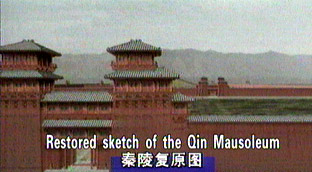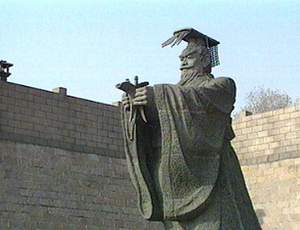 |
|
The First Emperor of Qin  |
|
|
 Qin Shi Huang, the First Emperor of Qin, was the first sovereign who adopted the title of emperor in Chinese history. With a pioneer's boldness of vision, he accomplished magnificent feats during his lifetime. Qin Shi Huang, the First Emperor of Qin, was the first sovereign who adopted the title of emperor in Chinese history. With a pioneer's boldness of vision, he accomplished magnificent feats during his lifetime.
The First Emperor of Qin was surnamed Ying and his given name was Zheng. At the age of 13, he became the king of the State of Qin towards the end of the Warring States Period. After fierce trials of strength, he removed his political opponents in the state. Then he started a war of annexation.
Hundreds of thousands of troops under his command swept across the Central Plains and reached the seaside. He established a great multi-national empire. In 221 B.C., Ying Zheng mounted the throne.
He gained state power from blood and fire. Yet this was only the beginning of his career. He was not only an outstanding strategist, but also a great statesman.
After he unified the country, he abolished the age-old system of enfeoffment and established the prefecture-county system. The empire was divided into a number of administrative divisions governed by officials who were appointed by the imperial court. The cause of separatist regimes of principalities was rooted out. This was a crucial step of political restructuring. Such a system existed for more than 2,000 years.
The empire of Qin took a series of measures to strengthen its effective control of the local authorities, laid the foundation of a unitary multi-national state and destroyed the feudal separatist regimes which had lasted for hundreds of years.
To build a unitary national market, the First Emperor of Qin ordered that a new currency be cast to replace the currencies of the six states. The round coin with a square hole was used as money in China for more than 2,000 years.
 The imperial edict on the standardization of weights and measures was read by people of later generations from archaeological findings and historical documents. Criteria were laid down for the country's economic performance and the people's life. The First Emperor of Qin could measure his territory with a single ruler instead of seven different rulers. The imperial edict on the standardization of weights and measures was read by people of later generations from archaeological findings and historical documents. Criteria were laid down for the country's economic performance and the people's life. The First Emperor of Qin could measure his territory with a single ruler instead of seven different rulers.
Under the separatist regimes of principalities, the Chinese characters had been written in different scripts. The lesser seal characters were adopted on the basis of those in use in the State of Qin. The standardization of the written language removed the obstacles to communication and facilitated the implementation of the emperor's decrees all over the country.
Those measures taken by the First Emperor of Qin greatly strengthened the cohesion of the country and the nation. After the State of Qin unified China, the Chinese gradually formed the concept of great unification of the country. They believe that unification is the mainstream of historical development while split is a temporary adverse current.
The historic contributions made by the First Emperor of Qin were coupled with evils. He forced a great many labourers to build his palaces and mausoleum, so the people had nothing to live on.
Culturally he carried out an extremely autocratic policy. The despotic rule destroyed the moral foundation of his political power. After the death of the First Emperor of Qin, his empire collapsed in a few years in the peasants' uprising. He left behind his great exploits and instructive lessons.
|
|
|
|
|
|
|
 |









